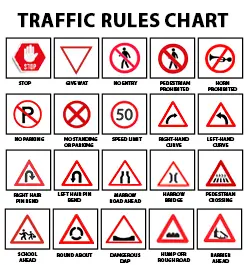

Online Legal Advice from Insaaf99® Online Lawyer Consultation in India


Online Legal Advice from Insaaf99® Online Lawyer Consultation in India

Traffic rules serve as the fundamental framework that governs the behavior of road users and ensures the smooth flow of traffic. These regulations are established to protect lives, prevent accidents, and maintain order on the roads. Adhering to traffic rules is not only a legal requirement but also a moral responsibility that each driver and pedestrian must embrace. This article explores the significance of traffic rules in promoting road safety, reducing congestion, and fostering a harmonious environment for all road users.
The primary objective of traffic rules in india is to prioritize road safety. These regulations define specific actions that drivers, pedestrians, and cyclists must take to prevent accidents and minimize risks. For instance, adhering to speed limits helps to control vehicle velocity, reducing the likelihood of collisions and allowing drivers ample time to react to unexpected situations. Rules such as wearing seat belts, using child restraints, and abstaining from drunk driving further contribute to protecting lives on the road. By following traffic rules, road users actively participate in creating a secure environment for themselves and others.
Strict adherence to traffic rules significantly reduces the occurrence of accidents and the resulting injuries. Rules regarding lane discipline, signaling while changing lanes, and yielding the right-of-way facilitate predictable and organized traffic patterns. This predictability enables drivers to anticipate and respond to the actions of others, minimizing the risk of collisions. Additionally, rules regarding pedestrian crossings, traffic signals, and zebra crossings provide a structured framework that protects vulnerable road users, such as pedestrians and cyclists, from potential harm. By respecting these rules, we contribute to a safer and accident-free road network.
Also Read :- Mutual Consent Divorce under Hindu Law
Traffic rules play a crucial role in managing the flow of vehicles on busy roads and intersections. Regulations pertaining to traffic signals, roundabouts, and stop signs allocate specific rights-of-way, ensuring a fair distribution of traffic and minimizing congestion. Following these rules not only prevents chaos but also enhances the overall efficiency of transportation systems. When drivers adhere to regulations such as maintaining proper distance between vehicles, using indicators, and avoiding unnecessary lane changes, the flow of traffic becomes smoother, reducing bottlenecks and gridlocks. In this way, traffic rules help optimize road capacity and enhance the driving experience for everyone.
Traffic rules not only apply to drivers but also protect the rights and safety of pedestrians. Regulations regarding crosswalks, pedestrian signals, and designated footpaths ensure that pedestrians can navigate roads safely. Drivers must yield to pedestrians at designated crossings, providing them with ample time to cross. By obeying these rules, drivers contribute to creating a pedestrian-friendly environment, fostering inclusivity, and reducing accidents involving pedestrians. Likewise, pedestrians must also follow rules such as crossing at designated points, waiting for the green signal, and avoiding distractions to ensure their own safety and promote efficient traffic flow.
Traffic rules instill a sense of responsibility and accountability in drivers. By following these regulations, drivers develop a disciplined approach to their behavior on the road. This includes respecting speed limits, avoiding reckless maneuvers, and refraining from distracted driving, such as texting or talking on the phone. Traffic rules encourage drivers to prioritize the safety and well-being of themselves and others, promoting a culture of responsible driving. This culture extends beyond adherence to rules; it encompasses ethical driving practices that prioritize courtesy, empathy, and respect for fellow road users.
Remember, traffic rules are in place to ensure everyone's safety on the road. By following these rules, you contribute to a more secure and orderly environment for all road users.

Please note that this chart provides a general overview of common traffic rules, but it is important to consult local traffic laws and regulations specific to your region as they may vary.
Also Read :- Financial Fraud: Threats, Impacts, and Safeguards: Identifying and Combating Modern-Day Scams
Traffic rules are the backbone of road safety, ensuring the smooth and orderly flow of traffic. By obeying these regulations, road users contribute to the prevention of accidents, reduction of injuries, and management of traffic congestion. Adhering to traffic rules is not only a legal obligation but also a moral duty that each individual must embrace to create a safe and harmonious road environment. Together, let us prioritize road safety and foster responsible driving behavior to make our roads safer for everyone. Remember, by respecting traffic rules, we save lives and create a more pleasant driving experience for all.
For more information consult with lawyer online.